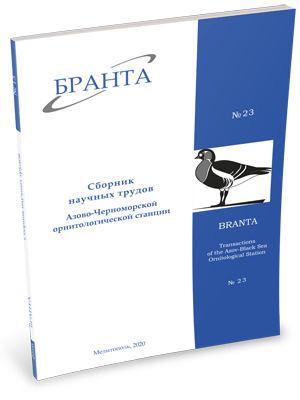
Transactions
of the Azov-Black Sea Ornithological Station



The first record of the Black-throated Accentor (Prunella atrogularis) and new finding of the Siberian Accentor (Prunella montanella) in Ukraine and possible reason for them
O. M. Arkhipov 1, H. V. Fesenko 2
2 – Schmalhausen Institute for Zoology, NAS of Ukraine
The article contains a new report on the caught individual of the Siberian Accentor (Prunella montanella) in Ukraine in 2016, namely in November near Kharkiv, that is, during the influx of this species to Europe. Ultimately, in November and December 2016, five individuals were recorded at four sites within the territory of Ukraine, data on three of which were published earlier. So, in the last two months of that year, more birds were trapped than 30 years before when in 1985 in Ukraine one individual of this accentor was caught for the first time. There is information about one individual noted on 2 November 2021 near the Lymanske village, which is not far from the Kuchurhan lyman in the Odesa region. This is the first reliable registration of the Siberian Accentor in this region for more than 180 years from the time when the first suppose about the presence of the species within Odesa was published. In addition, on 3 December 2021 an individual of the Black-throated Accentor (Prunella atrogularis) was observed for the first time within Ukraine also near the Kuchurhan lyman in the vicinity of the Kuchurhan village. This individual was recorded there again several times during winter 2021/22, and last time on 23 March 2022. In discussing the factors that determined the 2016 influx, a number of experts (Sikora & Ławicki, 2019) previously suggested the key role of such weather and climatic phenomena and their consequences as massive wildfires in Siberia with significant smoke, eastern winds and early winter. In terms of the scale of forest fires in Siberia, where the breeding areas of both species are located, 2021 became a record year in the current century (Forest fires…, 2021). These fires were caused by abnormal heat, dry and windy weather, a small amount of moisture accumulated in the winter period, i.e. in this year, arrivals of the observed individuals in Ukraine could be due to factors associated with climate warming.
Read the paper in a PDF fileReferences:
- Fauna of Belarus. Vertebrates. The Siberian Accentor (Prunella montanella). 2021. Retrieved from https://cutt.ly/BTnAsVQ [in Russian]
- Fesenko, H. V. 2018. The Ukrainian nomenclature of the birds of the world. Kryvyi Rih: Publisher FO-P Cherniavsky DO («Dionat»). [in Ukrainian]
- Fesenko, H. V., Peklo, O. M., Poluda, A. M. & Shybanov S. Yu. 2017. Consideration of mentions and records of the Siberian Accentor (Prunella montanella (Pallas, 1776) in Ukraine. Branta: Transactions of the Azov-Black Sea Ornithological Station, 20: 17–21. [in Ukrainian]
- Forest fires in Russia. 2021. Retrieved from https://cutt.ly/yTMHhzB [in Russian]
- Hagemeijer, E. J. M. & Blair, M. J. (Eds). 1997. The EBCC Atlas of European Breeding Birds: Their Distribution and Abundance. London: T. & A. D. Poyser.
- Hoyo, J., del, Elliott, A. & Christie, D. A. (Eds.) 2005. Handbook of the birds of the world. Cuckooshrikes to Thrushes (Vol. 10). Barcelona: Lynx Edicions.
- Hudyna, A. N. 2009. Rare and poor studied birds of Eastern Ukraine. Passeriformes. (Vol. 3.) Second edition, extended and corrected. Zaporizhzhia: Dniprovsky Metalurh. [in Russian]
- Keller, V., Herrando, S., Voříšek, P., Franch, M., Kipson, M., Milanesi, P., Martí, D., Anton, M., Klavaňová, A., Kalyakin, M. V., Bauer, H.-G. & Foppen, R. P. B. 2020. European Breeding Bird Atlas 2: Distribution, Abundance and Change. Barcelona: European Bird Census Council & Lynx Edicions.
- Ławicki, Ł. & van den Berg, A. B. 2016. WP reports: October to late November 2016. Dutch Birding, 38, 447–471.
- Mullarney K., Svensson L., Zetterström D. & Grant P. J. 2001. The most complete field guide to the birds of Britain and Europe. London: Harper Collins Publisher.
- Nordmann, A. 1840. Observations sur la Fauna Pontique. Voyage dans la Russie Méridionale et la Crimée, par la Hongrie, la Valachie et la Moldavie. Exécuté en 1837, sous la direction de m. Anatole de Demidoff. (Vol. 3). Paris: Ernest Bourdin et Comp., Editeurs.
- Orlenko, S. A. 2007. About records of indistinctive bird species in Kharkiv region. Birds of the Siversky Donets River Basin. Proceedings of the 13th and 14th conferences “Study and conservation of birds of the Siversky Donets River Basin”, 137–139. Donetsk, Ukraine. [in Russian]
- Peklo, A. M. 2008. Catalogue of the Zoological Museum collection, NSNHM, NAS of Ukraine. Birds. Vol. 4. Passeriformes (Alaudidae, Motacillidae, Prunellidae, Sylviidae, Regulidae, Paridae, Remizidae, Sittidae, Tichodromadidae, Certhiidae, Aegithalidae, Passeridae, Emberizidae). Kyiv: NSNHM. [in Russian]
- Shirihai, H. & Svensson, L. 2018. Handbook of Western Palearctic Birds. Vol. I. Passerines: Larks to Warblers. London: Helm.
- Sikora, A., Ławicki, Ł., Stępniewski, K., Sołowiej, M., Malczyk, P., Czerwiński, B., Janczyszyn, A., Barcz, M., Cząstkiewicz, D., Borowik, M., Chodkiewicz, T. 2018. Kolejne stwierdzenia płochacza syberyjskiego Prunella montanella w Polsce na tle nalotu jesienią 2016 w Europie. Ornis Polonica 59: 273–290.
- Sikora, A. & Ławicki, Ł. 2019. What brought about the influx of the Siberian Accentors to Europe in autumn 2016? A contribution to the debate. British Birds 112: 763–765.
- Stepanyan, L. S. 2003. Conspectus of the ornithological fauna of Russia and adjacent territories (within the borders of the USSR as a historic region). Moscow: “Academkniga”. [in Russian]
- Temminck, C.-J. 1835. Manual d’ornithologie, ou Tableau systematique des oiseaux qui se trouvent en Europe. (2nd ed). Paris.
- White, S. & Kehoe, C. 2018. Report on scarce migrant birds in Britain in 2016: passerines. British Birds 111: 519–542.
- 2021 became a record year for the area of forest fires in Russia since the beginning of the XXI century. 2021. Retrieved from https://cutt.ly/lTnA11e [in Russian]